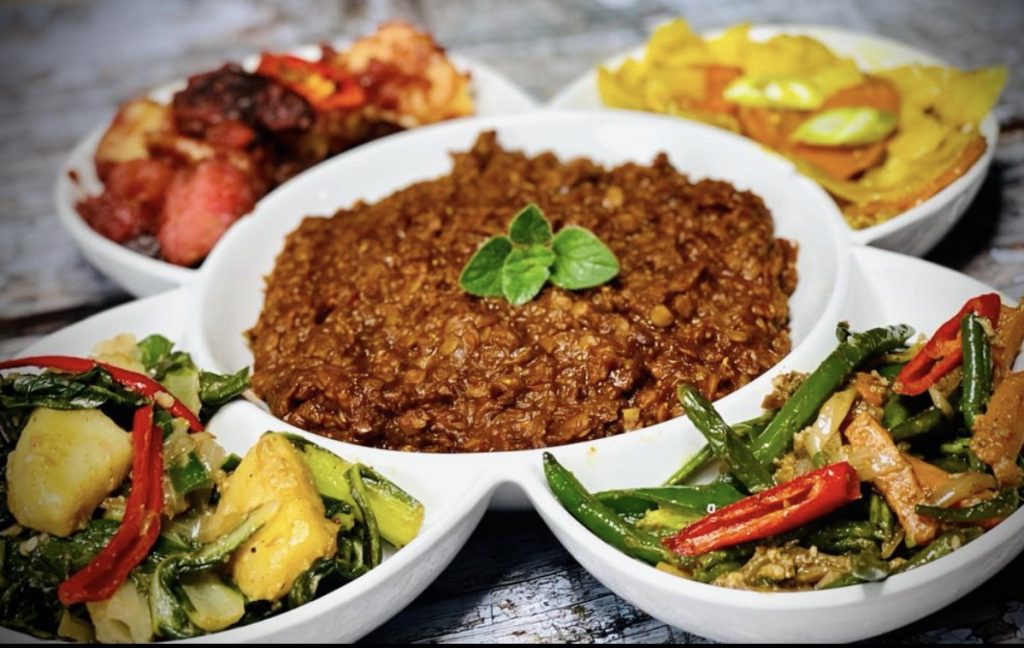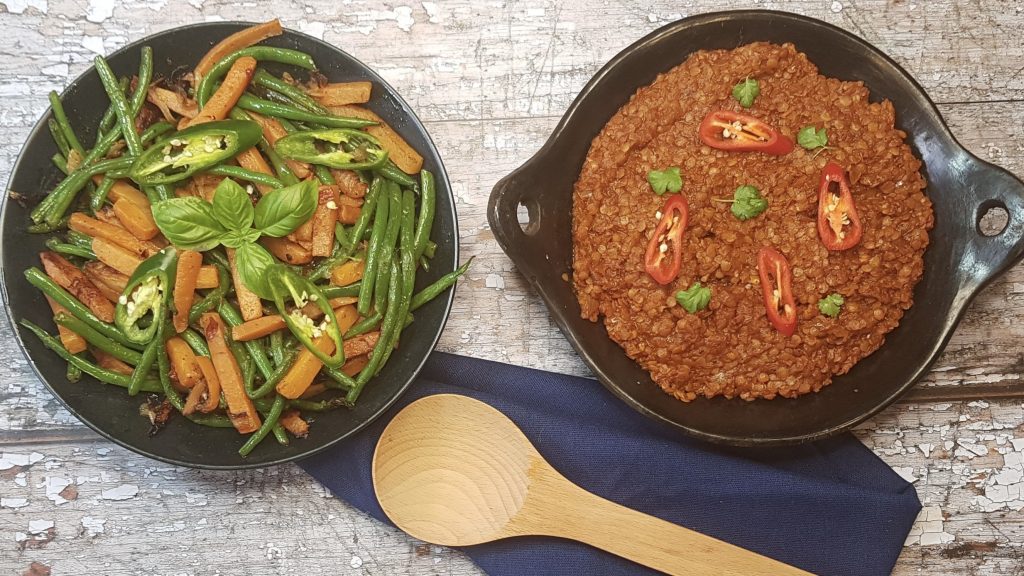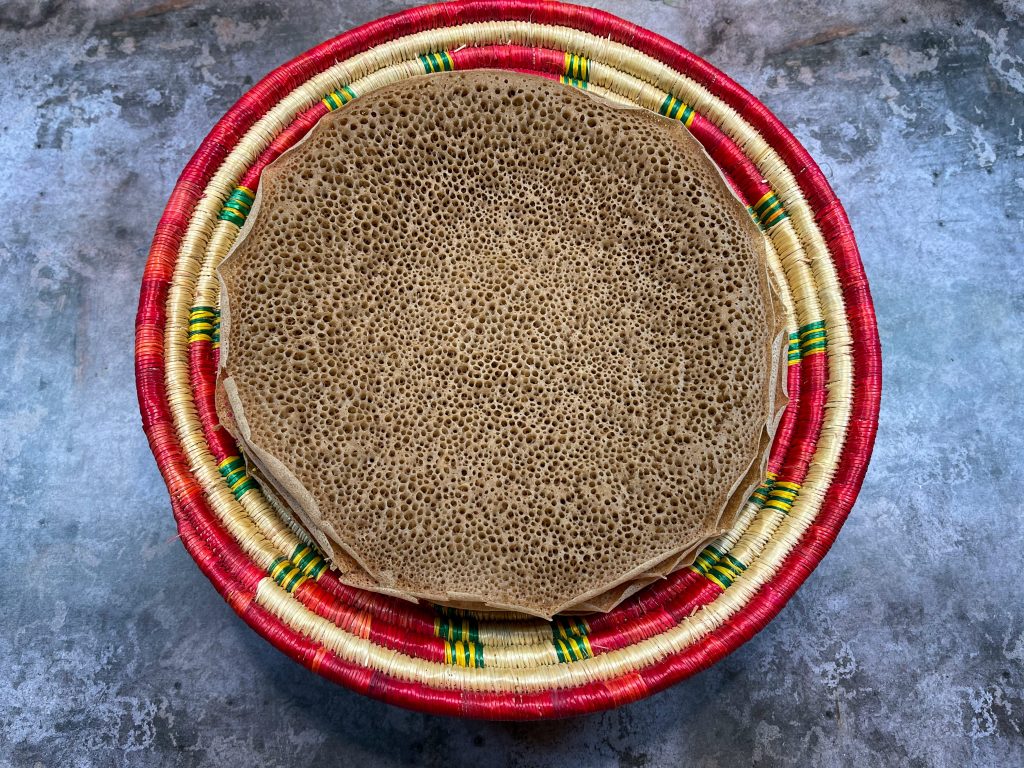
Unless you are an adventurous foodie, chances are you know little about Ethiopian food. That is partially why one of my favorite past times is inviting friends from other cultures to try my cultural cuisine. Ethiopian culinary culture is very much informed by the country’s long history, rich endemic food sources, ethnic diversity, religion, and generationally passed down food customs and rituals.
Gathering around a big round plate, adorned with the vibrant colors of our vegetarian and meat platters provides the perfect opportunity for a crash course on all things Ethiopia.
So, taking friends to have Ethiopian food is more than sharing the immediate moment with them. With every dish, I get to tell them about the ingredients used, which part of Ethiopia it hails from, and the personal and cultural significance it holds for me and many others like me. And in this post, I get to share some of this with you, what the Ethiopian dietary pattern looks like, our long-held behaviours around food and eating and how this generational customs fit within the current evidence into nutritional health and general wellbeing.
So, what does the Ethiopian Dietary Pattern entail?
Aside from the personal and emotional significance of cultural foods, the Ethiopian dietary pattern boasts many beneficial features that could play a positive role in health and overall wellbeing. These are some of the main components of the Ethiopian traditional diet.
1. It is a minimally processed diet
Ethiopians, by and large, consume locally sourced foods making industrially processed foods virtually unheard of until the effect of globalization took hold. Despite the availability and ease of pre-packaged foods now, Ethiopians continue to eat minimally processed foods, using whole and seasonal ingredients.
The ‘minimal’ in processing occurs mainly at home. Most of the preparation and processing practices follow the indigenous knowledge that have demonstrated continuity through generations. Time-tested methods, such as blending of spices, fermentation, germination, soaking, and heat treatment are applied to ingredients in order to improve the sensory qualities of staple foods and as a way to preserve food products for extended period of time.
Main staple foods (such as injera and Kocho), key ingredients (such as shiro), spice blends (berbere), snacks (kollo and nefro), as well as traditional beverages (such as Ergo, tella, and tej) go through intricate traditional processing phases which take days to weeks to achieve their final culturally desirable forms.
2. Follow generational dietary customs
Food is one of the most essential marker of the Ethiopian cultural identity and the indigenous dietary customs and culinary traditions are at the core of this cultural expression
In Ethiopia, food is at the center of all major social occasions, happy or sad. A spread of cultural dishes are often nearby whether we are celebrating the good times or comforting each other through difficult ones. As such, a great level of respect is assigned to food.
The same respect is extended to regular eating habits. At home, meal times mark pivotal part of familial interactions, as such they are structured, and to a large extent, formal. Modern dietary habits such as grazing (the act of continuous snacking), eating while walking outdoors, talking with food in your mouth, are traditionally discouraged and highly frowned upon.
These long-standing food ‘rules’ and practices are ingrained in the psyche of most Ethiopians, even those in the diaspora unconsciously follow these dietary habits far away from home. Evidence from multiple studies have shown that these qualities, such as fixed meal times, dining together, and avoiding incessant snacking, are found to positively impact not only physiological but also psychological wellbeing.
3. It is a predominantly plant-based diet
As with any part of the world, a plant-based diet is relatively more affordable and accessible in Ethiopia than foods from animal sources. The plant-based way of eating in Ethiopia is however influenced by multiple factors aside from its cost-effectiveness.
The main influence comes from the Ethiopian Orthodox Christian church where followers make up around 43% of the nation’s population. The church dictates observers commit to fasting for a total of 250 days per year, including most Wednesdays and Fridays. This involves following periodic veganism where devotees abstain from consuming meat and dairy products.
The influence of this religious tradition is far-reaching and widespread so much so even non-followers have adopted the plant-based dietary pattern over time. As a result, Ethiopian cuisine tend to boast an array of plant-based dishes which have been perfected for generations.
Legume-based Dishes

Legumes are used in in variety of forms, including as key ingredients for signature plant-based stews as well as to make commonly consumed snacks such as shimbra and kolo. Among the nation’s most commonly consumed dishes are Shiro Wot (chickpea stew and its variants), Miser Wot (Lentil Stew), Kik Alicha (Yellow split peas), and Fasolia (Sautéed green beans).
legume-based traditional dishes are excellent sources of plant protein and essential amino acids, as well as dietary fiber and B vitamins. They are also rich in minerals such as, potassium, phosphorous, manganese, and copper and contain fair amount of iron, calcium, and zinc. Moreover, the glycemic index of these commonly consumed dishes are markedly low with estimated values of 19 (Miser Wot), 27 (Kik Alicha), 44 (Shiro Wot), and 46 (Fasolia).
In addition to their respective legume variety, most, if not all of these dishes incorporate onion, garlic and ginger in abundance, as well as spice blends (berbere and mekelesha ), further augmenting the nutritional profile of the staple dishes.
Staple vegetable dishes

Vegetable staples make up half of the most common plant-based offering in Ethiopian diet. Among the regularly consumed vegetable dishes are ye Habesha Gomen (Ethiopian kale/collard greens), key sir Alicha (beets), Tikel Gomen (cabbage), and Dinich wot (potato stew).
Consumption of vegetables as part of an overall healthy dietary pattern is found to positively influence health and reduce the risk of developing chronic diseases such as heart disease, some cancers, and other metabolic syndromes. Traditionally prepared vegetable dishes contribute to a significant proportion of daily macronutrient intake as well as being excellent sources of dietary fiber. These staple dishes are also rich sources of vitamins (vitamin C, Vitamin B6, Vitamin E, and folate) and essential minerals (potassium, chloride, iron, and calcium). Aside from dinich wot, the estimated glycemic index of the vegetable dishes ranges from low (Ye habesha gomen and tikel gomen), to moderate (key sir).
4. Moderate consumption of animal source staples

For the majority of the population, animal source foods are not part of their daily dietary pattern and the frequency in which people in Ethiopia consume animal source foods largely depends on the financial status of Ethiopian households, availability, and religious practices.
There is however a huge selection of dishes of animal source including beef and lamb Sauté (Tibs), ground beef (Kitfo) and stews from lean-cut meats and poultry such as Doro Wot (chicken stew) and Siga Wot (meat stew). Diary-based products in various forms are major staples in Ethiopia and are consumed on their own, as a side dish, or seasoning. For example, Ergo is a traditional fermented milk similar to yogurt, Ayib, a homemade Ethiopian cheese often eaten alongside a spicy meat dish to contrast the heat, and Kibe, a traditionally spiced clarified butter added to enhance the flavor of most dishes.
5. Abundant use of herbs and spices

Similarly to the Mediterranean diet, Ethiopian dietary pattern utilizes herbs and spices in abundance, its use dating back to 4500-1900 BCE. The use of assorted spices and herbs are integral part of the Ethiopian diet and have been central to the country’s culinary and medicinal culture for centuries. Both wild and cultivated herbs and spices have multiple purposes and are used in variety ways including for flavor enhancement, food preservation, as well as traditional medicine.
Although the conventional research into the role of spices and herbs in promoting health and disease prevention is still developing, their potential as functional foods specifically for their antioxidant, anti-carcinogenic, and anti-inflammatory properties is becoming more acknowledged.
6. Injera, the holy grail of Ethiopian cuisine

Think of Injera as the Ethiopian answer to rice in Asian countries, except it is a spongy and porous gluten-free flatbread that most, if not all, Ethiopian dishes are accompanied by. A fermented by-product of the indigenous Teff grain, injera has recently gotten many global accolades and is perhaps one of the most internationally recognized staple food sources in Ethiopia. It is a custom that we use our hands, rather than forks and knives to eat. That’s why we often say Injera serves a dual purpose, as a bedding for our choice of dish as well as a utensil to scoop up a bite.

Hanna Haile is a Registered Associate Nutritionist with specialty in global public health nutrition and health promotion. Hanna is the Founder of Heritage Nutrition and provides culturally-inclusive guidance to people from diverse backgrounds. Her work revolves around helping clients realise their nutritional and health goals through a set of evidence-based dietary and lifestyle strategies. Hanna is also a health & Nutrition writer and Published Author in Journal of World Public Health Nutrition.
Disclaimer: This article is not, nor does it try to be, a substitute to the advice of your medical care. You should follow the treatment and recommendations of your doctor and specific dietician at all times. Please check out our full disclaimer on our website here